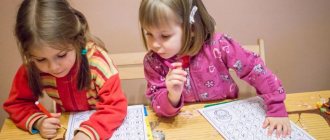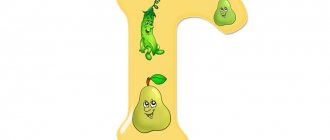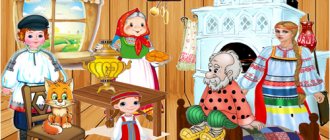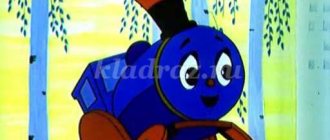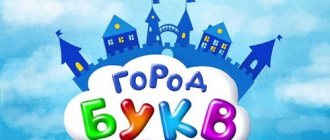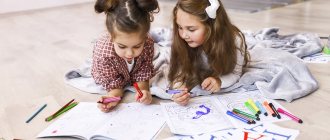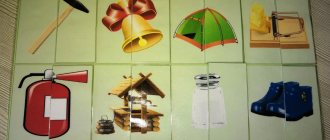Today it has become the norm that a child entering school requires much more knowledge and skills than was the case two or three decades ago. One of the important requirements for the volume of knowledge is learning letters. Nowadays, children are taught letters and sounds in preschool and various school preparation groups. However, knowledge will become more complete if preschool children constantly replenish and consolidate it in home education. Parents will be able to effectively teach their child if they use techniques for introducing children to letters, sounds, words and follow certain recommendations. What should adults know to teach a child letters?
Preschool age is the best period for learning letters
Many parents with small children have a question: when is the best time to start learning the alphabet? There are several opinions on learning letters by preschoolers:
- According to many modern parents, it is necessary to teach a child to read as soon as he speaks. They begin to master original techniques and purchase special manuals. However, there is not always enough patience and knowledge to complete the training that has begun. Therefore, the task of parents is to organize home schooling in such a way that both adults and children can do it.
- According to psychologists, there is no need to rush to teach your child the alphabet. If a child is not ready to perceive educational material, he may develop a persistent reluctance to learn letters and subsequently read. After all, this is a rather difficult task, requiring mental tension, attention, and speech. Experts believe that the optimal age for learning letters is 4–5 years, when the child is psychologically ready to learn. At this age, interest in everything new and a desire to be like an adult are more evident. Adults should take advantage of this interest and desire to learn new things.
- According to teachers (authors of early learning to read N. Zaitsev, G. Doman, V. Voskobovich), you can teach your child the alphabet much earlier than preschool age, for example, at one to two years old, if the baby shows such a desire.
The main thing that parents need to remember is that teaching should be free of coercion. Important: parents need to understand why we teach letters with a small child. If a preschooler under 4-5 years old really wants to learn the alphabet, then his desire should be encouraged. And if this is a tribute to fashion and the parents’ desire to keep up with others, then there is no need to rush. It is better to focus on general intellectual preparation and development of the speech apparatus by reading books, composing creative stories, inventing fairy tales, memorizing poems and sayings. Then preparation for school in senior preschool age will take place without stress. The preschooler himself will strive to keep up with his peers, acquire new knowledge, and actively behave in home classes to learn the alphabet.
Letter eater.
A cheerful Bukvoeshka may appear in your home. The easiest way to do this is to take a glove doll or a soft toy.
For example, this cockerel -
very unusual! He eats letters! Come on! Let him eat the letter B! And now he wants the letter A! Oh, how deliciously you feed the cockerel!
You can play the letter game in another way:
Funny people live in this box. They eat nothing but letters. Let's feed them? (the little people’s mouths are slits in the box).
Here is their food (we draw letters on the beans with a felt-tip pen):
We feed the little men (each little man has his own letter, if the baby makes a mistake, the little men spit merrily, close their mouths and demand to be fed another food that suits them better (beans with “their” letter):
Recommendations for getting to know the alphabet
To make learning about letters an interesting and accessible activity for preschool children and encourage them to further learn to read, parents need to get acquainted with the recommendations of specialists. This will make it possible to easily organize home classes. So, what are the principles by which we teach letters with children:
- Play, the leading activity in preschool age, should become the main method of teaching children, so the principle of homework is to learn letters by playing.
- Getting to know the alphabet is quite a difficult task for preschool children, so the work is carried out gradually, from simple to complex. There is no need to require your child to mechanically memorize the entire alphabet at once. At each lesson, you need to meaningfully practice one letter, consolidate previous material and master new ones.
- Before starting training, an adult must learn to correctly name letters: clearly and stressed consonants (b, but not “be”, m, r, s, but not “em, er, es”). The child must be taught to pronounce vowels in a drawn-out manner, for example, a - a-a.
- It is more useful to study sounds and letters at the same time to develop further syllable reading skills. This technique will help maintain interest in rather monotonous tasks. You can begin to compose syllables when the necessary supply of letters appears (ba, ma, pa, yes). It is also necessary to show that the letter being studied is necessarily included in some words, for example, a - watermelon, o - autumn, y - snail, etc.
- Experts recommend introducing letters and sounds in the order in which they are formed in ontogenesis (individual development of the body). First of all, these are the vowel sounds a, o, u, s, e and consonants. The vowels i, e, ё, yu consist of two sounds, so they are learned at an older age.
- Consolidating knowledge about letters should be accompanied by activities that are interesting for the child: drawing, modeling, appliqué, design. For this purpose, experts have developed many games and exercises that can be used in preparation for homework.
Halves is a game to consolidate knowledge about already familiar letters.
In the process of learning the alphabet, the process of repetition is important. Still would! After all, by the time you get to “I”, you must try not to forget the letter “A”.
The process of repeating already learned material will be more fun with the game “Halves”!
Cut out beautiful cards with letters, cut them into two parts, mix them.
Invite your child to “fold” letters from two halves.
Games and exercises for home activities
How to teach your child letters at home? In addition to special aids, such as a primer, the alphabet, in psychological and pedagogical practice you can find many interesting tasks for consolidating knowledge about letters and sounds. Such collections will help parents organize home schooling competently and, most importantly, in an interesting way. There is no need to take on complex gaming tasks; the simplest games can become a fun learning tool for kids.
We are building an unusual house
A simple game exercise with cubes will help reinforce the names of the letters. An adult can purchase ready-made cubes with images of letters; together with your child, you can prepare homemade ones, for example, by painting ordinary wooden cubes. With their help we learn letters, for example:
- Let's build a ladder of letters that can sing (vowel sounds a, o, u, s, e);
- Let's build a house for the doll from cubes with different letters and teach them to call them d, o, m;
- Let's show the correct cube - the answer, for example, to riddles with the letter b:
I walk around in a fluffy fur coat, I live in a dense forest. In a hollow on an old oak tree I gnaw nuts (squirrel)
There are workers in the river, neither joiners nor carpenters, but they will build a dam - at least paint a picture (beavers)
- Let's find a cube where a stork is drawn (ask what the first letter is).
Parents' creativity can help make playing with blocks fun. Cubes with a certain letter can be placed everywhere: in the room, kitchen, hallway; on the closet, TV, table, windowsill, so that they constantly accompany the baby.
Where is the letter hidden?
An adult places one copy of the letters in different places in the room, and hangs the other in a visible place for comparison. Among them is a letter that the child needs to find. The game is played according to the “hot - cold” type. The player follows the adult’s instructions, for example: go straight, then turn left, take two steps, turn left again. The leader directs the movement using the words “cold, warmer, cold again, warm, hot.” On the way, the baby finds other letters and compares them with the one he is looking for. In addition to consolidating letters, spatial skills are developed.
Who can collect the letters faster?
It is advisable for several participants to play, so it is good if the whole family takes part in the game. Pictures with different images of the same letter are laid out on the court, and the players, at the leader’s signal, begin to collect them. It’s good to use funny rhymes, you can write your own, to create a positive mood, for example: “An arrow leads us to the letter b. Here is a birch tree, and here is a squirrel.” The one who collects the most images faster wins. There must be a student among the winners.
Bag with letters
We study letters with the children using the classic version of the “wonderful bag”. An adult prepares a beautiful bag, puts small objects in it, the name of which begins with the letter being studied, for example, “r”: pen, fish, strap, comb, daisy, robot. The child takes out the object and clearly pronounces the word. In the future, the game becomes more complicated because the letter being studied moves to the middle and end of the word.
What does the letter look like?
The game is played according to the type of associations (images that arise in the mind in response to a letter). Such tasks help children easily remember letters, without repeating them many times. Associations can be something like this: come up with an object that the letter looks like ( A is like the roof of a house, O is a steering wheel, a wheel, U is a twig fell from a tree, F is a bug, P is a collar). In this exercise it will be interesting to use rhymes that can be found in any textbook for preschoolers, for example:
B is like a trumpet that buzzes: “Boo-boo, boo-boo”!
Looks like B , no doubt, like pretzels, a bicycle.
the letter D , it’s sailing towards us like a boat.
The letter Z is just like a beetle, perched on a branch.
Educational online games
In addition to classical games and exercises, online games are actively used as one of the techniques in modern pedagogy. They can be successfully introduced into home activities. The main thing is to remember that the time spent at the computer should be limited for preschoolers to 10 to 15 minutes. Games must also correspond to the age of the children, level of knowledge and methodological requirements, for example, for children online - the game teaches them to correctly name letters, for older preschoolers - to remember the order of letters, form syllables, and look for missing letters in words. We learn letters with children using, for example, such games:
Talking alphabet for children
The talking alphabet works wonders! Press any letter and immediately get the word! In the game, the preschooler fixes the correct name of the letter and sees a picture that depicts an object for this letter. It is useful to practice this task for those children who are just beginning to recognize letters. You can make the game more difficult for older preschoolers by asking them to remember their order in the alphabet.
Connect the dots
Games like connecting dots with one line are intended for older preschoolers; they help remember the order of letters and distinguish between vowels and consonants. For example, one of these online games is “Little Foxes,” in which, using the correct combination of letters, a funny picture is created. The player, by pressing the keyboard buttons and connecting the dots, remembers the letters. If the task is completed correctly, the winter forest will be covered with snow. A more complex option: the preschooler is explained that vowel letters (singing) are colored red, consonants are colored blue (hard), and green (soft). The child must pronounce them with correct articulation.
Memory.
To consolidate the material covered, the well-known game “Memory” is also suitable (at the same time, attention and memory are trained). You will need a set of cards in which each of the pictures with a certain letter is presented in duplicate.
Shuffle the cards and place them in front of the child, white side up.
Ask him to turn over any of the cards, name the sound that the open letter represents. Then the player needs to find exactly the same card among the others that have not yet been turned over. The player looks for the desired letter by turning over the remaining cards and checking what is written on them.
Did you open the wrong letter? Turn it back to the white side up and look for a pair further!
When the required card is found, the player takes two cards for himself and the game continues until a pair is found for each card.
How to teach your child the alphabet using creativity
Parents will be interested to know that in addition to the classic methods of learning about letters, there are other exciting methods that will interest both adults and children. They are based on creative activities, which always attract preschool children: appliqué, drawing, modeling, design.
Application
An adult and a child cut out letters from thick paper of a fairly large size. Then comes the preparation of decorations, this can be cereals, fabric, colored paper, beads. Decorations are applied to stencils using glue. The result is bright, beautiful letters that can be assembled into a garland and placed in different places (children's corner, wall, on the Christmas tree).
Drawing
Drawing letters is an original technique for memorizing them. You can draw on paper with felt-tip pens, on a board and asphalt with crayons, or with a stick on the sand. For the same purpose, you can use all kinds of coloring books, old magazines, in which you can search with your preschooler and trace familiar letters with a felt-tip pen.
Modeling
Letters will be remembered faster if you hold them in your hands and manipulate them, that is, sculpt them. At the same time, it is a good tool for the development of fine motor skills directly related to speech. Plasticine, clay, and salt dough are suitable for this purpose. Just like in applique, finished letters can be decorated with polka dots, beads, or simply painted with gouache paints.
Construction
Building letters is a fun activity for kids! It helps not only to consolidate the alphabet, but also develops hand motor skills, thinking, attention, and the desire for associations (seeing letters in surrounding objects). You can build or design letters not only from a special construction set (metal, wood, plastic), but also from any available material material. For example, from sticks, matchboxes, little hardcover books. Everything your imagination is rich in can become material for constructing letters.
Dear parents! In modern pedagogy there are many original methods with which you can quickly learn letters and move on to reading. Every parent can teach their child letters. However, every parent must remember that learning should bring joy to the child, a living desire to learn new things, and not be a tedious, monotonous task. Your meaningful decision, patience, and love for your child will help you achieve good results. Good luck with raising your children!
Let's sculpt.
A very useful activity is to sculpt letters from colored dough or plasticine. And if you combine sculpting with listening to Ekaterina Zheleznova’s songs from the album “Musical Primer” (in which the whole sculpting process is “sung” in a very interesting way), then sculpting will be even more fun.
Wonderful mothers, passionate about the development of children, have long made funny videos from these songs and posted them online.
For example, while playing and watching a funny video, you can make the letter A in a fun and interesting way:
Tilt two sticks
Connect at the top
One crossbar -
Like a letter A tent!
"Find it!"
Find all the letters “K” in this picture and circle them!
And in this picture there are all the letters “T”:
Find all the red letters “M”... And now the blue ones... And now the orange ones, etc.
Now count - how many letters “M” did you find in total?
Outline.
This is a great game for learning how to write letters.
Draw the letter with paints. And then ask your child to circle it with a different color... or several colors. Of course, it is better to draw the letter on an A4 sheet.
You can even “write” entire words this way:
